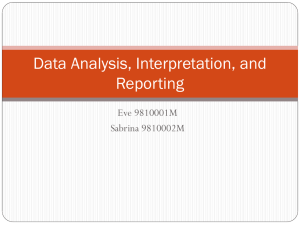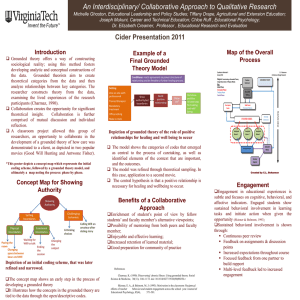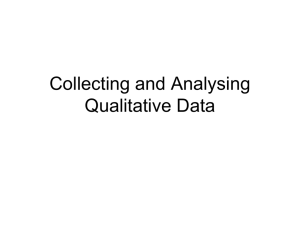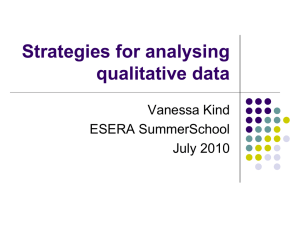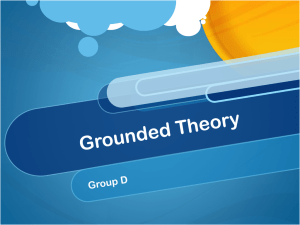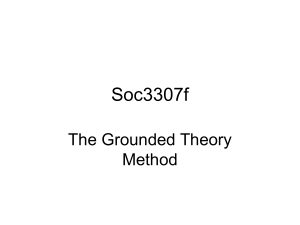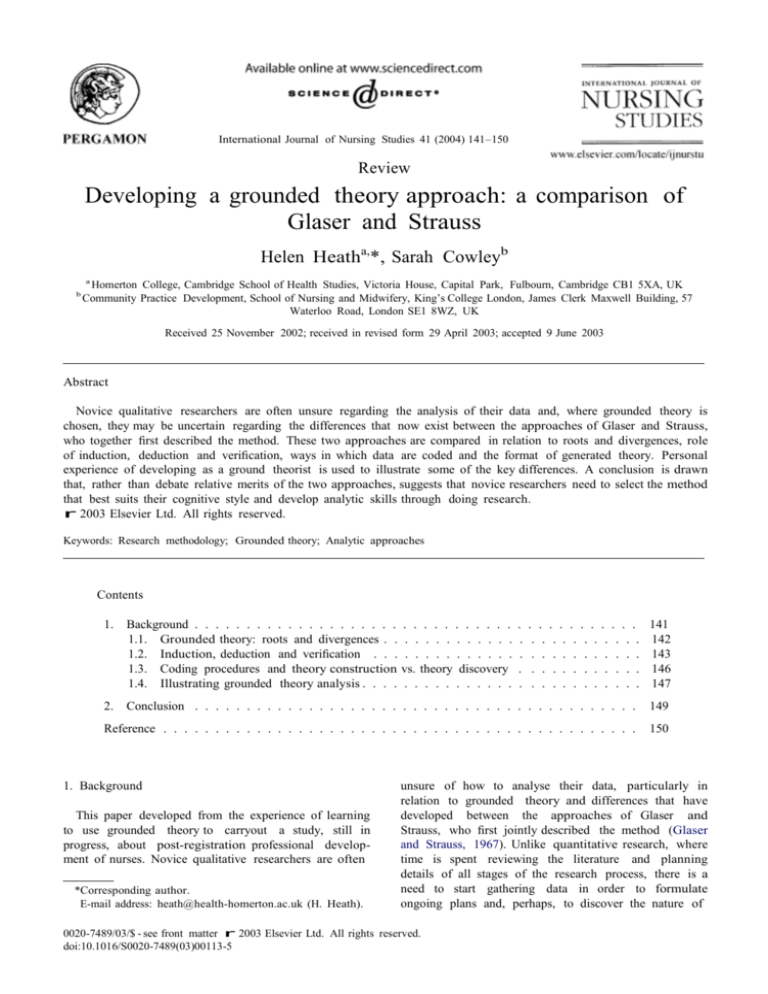
International Journal of Nursing Studies 41 (2004) 141–150
Review
Developing a grounded theory approach: a comparison of
Glaser and Strauss
Helen Heatha,*, Sarah Cowleyb
a
b
Homerton College, Cambridge School of Health Studies, Victoria House, Capital Park, Fulbourn, Cambridge CB1 5XA, UK
Community Practice Development, School of Nursing and Midwifery, King’s College London, James Clerk Maxwell Building, 57
Waterloo Road, London SE1 8WZ, UK
Received 25 November 2002; received in revised form 29 April 2003; accepted 9 June 2003
Abstract
Novice qualitative researchers are often unsure regarding the analysis of their data and, where grounded theory is
chosen, they may be uncertain regarding the differences that now exist between the approaches of Glaser and Strauss,
who together first described the method. These two approaches are compared in relation to roots and divergences, role
of induction, deduction and verification, ways in which data are coded and the format of generated theory. Personal
experience of developing as a ground theorist is used to illustrate some of the key differences. A conclusion is drawn
that, rather than debate relative merits of the two approaches, suggests that novice researchers need to select the method
that best suits their cognitive style and develop analytic skills through doing research.
r 2003 Elsevier Ltd. All rights reserved.
Keywords: Research methodology; Grounded theory; Analytic approaches
Contents
1.
Background . . . . . . . . . . . . . . . . . . . . . . . . . . . . . . .
1.1. Grounded theory: roots and divergences . . . . . . . . . . . . .
1.2. Induction, deduction and verification . . . . . . . . . . . . . .
1.3. Coding procedures and theory construction vs. theory discovery
1.4. Illustrating grounded theory analysis . . . . . . . . . . . . . . .
. . . .
. . . .
. . . .
. . . .
. . . .
141
142
143
146
147
2.
Conclusion . . . . . . . . . . . . . . . . . . . . . . . . . . . . . . . . . . . . . . . . . . .
149
Reference . . . . . . . . . . . . . . . . . . . . . . . . . . . . . . . . . . . . . . . . . . . . . .
150
1. Background
This paper developed from the experience of learning
to use grounded theory to carryout a study, still in
progress, about post-registration professional development of nurses. Novice qualitative researchers are often
*Corresponding author.
E-mail address: heath@health-homerton.ac.uk (H. Heath).
.
.
.
.
.
.
.
.
.
.
.
.
.
.
.
. .
. .
. .
. .
. .
. . .
. . .
. . .
. . .
. . .
unsure of how to analyse their data, particularly in
relation to grounded theory and differences that have
developed between the approaches of Glaser and
Strauss, who first jointly described the method (Glaser
and Strauss, 1967). Unlike quantitative research, where
time is spent reviewing the literature and planning
details of all stages of the research process, there is a
need to start gathering data in order to formulate
ongoing plans and, perhaps, to discover the nature of
0020-7489/03/$ - see front matter r 2003 Elsevier Ltd. All rights reserved.
doi:10.1016/S0020-7489(03)00113-5
142
H. Heath, S. Cowley / International Journal of Nursing Studies 41 (2004) 141–150
the research questions. Yet even here, instructions
provided by Glaser and Strauss differ in their more
recent, separate texts (Glaser, 1978, 1992, 1998, 1999;
Strauss and Corbin, 1990, 1994, 1998).
Awareness of the methodological mistakes in many
published grounded theory studies (Becker, 1993;
Skodal-Wilson and Ambler-Hutchinson, 1996) adds to
the level of anxiety. Morse (1991) recommends that only
experienced researchers mix methods, but does that
applyto the two different approaches espoused,
respectively, by Glaser and Strauss? A tension exists
between a need to understand grounded theoryby
reading about it and a recognition that the novice
researcher must find out ‘‘about the process of
researching through learning in the process of carrying
out the research’’ (Freshwater, 2000, p. 29).
This paper is intended to help other novice researchers
faced with this dilemma, byunravelling and exploring
the two approaches, comparing them in relation to the
role of induction, deduction and verification, ways in
which data are coded and the format of generated
theory. The paper will begin by examining grounded
theory’s roots and divergences before comparing the
approaches of its two originators in some depth. In
conclusion, although no attempt is made to describe the
detail of the study, some excerpts of data are used to
illustrate experiences of coding using first a Straussian,
then a Glaserian approach to analysis.
1.1. Grounded theory: roots and divergences
Grounded theory’s roots lie in symbolic interactionism, which itself stems from pragmatist ideas of James,
Dewey, Cooley and Mead (Hammersley, 1989), most
notablythe concept of the looking glass self (Cooley,
1922). Individuals are self aware, able to see themselves
from the perspective of others and therefore adapt their
behaviour according to the situation (Mead, 1934).
Social interactions create meaning and shaping of
societyvia shared meaning predominate over the effect
of societyon individuals. The term ‘symbolic interactionism’ was invented by Blumer (1937) and his
development of the interactionist approach together
with naturalistic inquiryis a key influence on grounded
theory. Blumer (1956) stressed the role of concepts that
are sensitising rather than definitive, that gain their
utilityand significance from patterned relationships
rather than quantifiable correlations. Moreover, Hammersley’s (1989) detailed analysis shows that Blumer’s
concept of inquiryinvolved comparison of cases to
develop the features of each case, the production of
emergent meaning and ongoing refinement of the
characteristics of the relationship.
Parallels with
grounded theorywhere concepts are related and
developed around a core via a process of ongoing
comparisons are clear.
Since its initial development grounded theoryhas
diversified. Adaptations maybe acknowledged bythe
author, e.g. Schatzman’s (1991) dimensional analysis,
Chenitz and Swanson’s (1986) surfacing the nursing
process and the Keddyet al. (1996) extension of macroanalysis beyond that of symbolic interactionist interpretation to address feminist socio-political concerns.
However, the most important variation is between
Glaser and Strauss, the founders of grounded theory.
Stern (1994) claimed that the differences between the
two researchers had always been apparent, but it was
not until Strauss published detailed guidance to the
grounded theoryprocess (Strauss, 1987; Strauss and
Corbin, 1990) that the divergence was more widely
recognised. Glaser (1978, 1992) is generallyseen to have
remained faithful to classic grounded theorywith
Strauss and Corbin (1990) producing a reformulation
of the classic mode (Annells, 1996) with Glaser (1992)
claiming that the Straussian approach is no longer
grounded theory, but ‘full conceptual description’.
Glaser (1978) had extended grounded theorybeyond
the original text (Glaser and Strauss, 1967) to explain in
more detail concepts such as theoretical sampling,
theoretical coding and use of theoretical memos, but it
was Strauss and Corbin (1990) who focused on
developing the analytic techniques and providing
guidance to novice researchers. This emphasis has been
the focus of some criticism with Keddyet al. (1996)
believing it produced a rigiditynever intended for
grounded theory, while Robrecht (1995) held that
emergence is problematic. However, it is methodological
rather than ontological and epistemological aspects that
have been cited as the main source of divergence.
Indeed, Hammersley(1989) sees an ontological paradox
inherent in Blumer’s symbolic interactionism that is
relevant to all grounded theory: if meaning is conferred
on the social world byinteraction of actors, can there be
a realityof basic social processes to be investigated?
Hammersley(1989, p. 135) claims that the paradox is
easilyresolved:
once we accept that there can be multiple non
contradictorydescriptive
and
explanatoryclaims
about anyphenomenon.
He links this to Mead’s (1934) concept of sociality
which means that a phenomenon can be several
things at once. Thus, grounded theory’s aim is to
explore basic social processes and to understand the
multiplicityof interactions that produces variation in
that process.
A shared ontologycan thus be assumed, but there
maybe slight epistemological differences. Fundamental to
grounded theoryis the belief that knowledge may be
increased bygenerating new theories rather than
analysing data within existing ones. However, there are
H. Heath, S. Cowley / International Journal of Nursing Studies 41 (2004) 141–150
philosophical differences between Glaser and Strauss in
the process of theorygeneration with different emphasis
on induction, deduction and verification and also in the
form that theoryshould take.
1.2. Induction, deduction and verification
There is a tension at the heart of the qualitative
research between presentation of data and its interpretation. While the role of interpretation varies with
different approaches some interpretation will always be
present, even if confined to the selection of events and
details relevant and the waya narrative account is
presented (Poirer and Ayres, 1997).
No one would claim to enter the field completelyfree
from the influence of past experience and reading. Even
if this were possible, ignorance is not synonymous with
generating insider understanding (Morse, 1994). Attending to the data cannot ignore prior understandings and
it could be claimed that the phenomenologist’s concept
of bracketing or holding preconceptions, values and
beliefs in abeyance is fundamentally flawed. Analysis
will always be filtered through one’s tradition and
cultural position (Ashworth, 1997). Furthermore, symbolic interactionism and thus grounded
theorysees
researchers as social beings whose experiences, ideas and
assumptions can contribute to their understanding of
social processes observed (Baker et al., 1992). There are
two issues involved here: the extent to which preunderstanding is enhanced byearlyreference to the
literature and ongoing use of self during analysis, i.e. the
role of induction, and emergence vs. deduction and
speculation.
Cutcliffe (2000) suggested that decisions about the
literature depend on two factors. The first decision
related to whether the researcher has little knowledge
about the phenomena and process of interest and
remains unsure about the most suitable approach, or is
alreadyaware that there is a lack of knowledge and has
decided on a grounded theorymethodology. Either
possibilitycould exist if the research topic lies outside
one’s practice or academic interest, but this is uncommon in nursing; indeed, familiarityis generallya
problem (Field, 1991; Lipson, 1991) and on this issue
it maybe best if further reading is avoided at first.
Cutcliffe’s (2000) second argument is that prior reading
maybe required if the researcher wishes to clarify
concepts and build an emergent theoryon these. The
argument goes against one of the most basic tenets of
grounded theory, as does the rationale of distinguishing
between factor isolating and factor relating theory
(Dickoff and James, 1968) on which it is based.
Grounded theoryboth discovers and relates concepts
and a theorycannot be simultaneously emergent and
built on concepts selected from the literature. The
approach has been attempted by Jezewski (1995) who
143
carried out a literature-based concept analysis of culture
brokering before attempting to further develop the
concept via grounded theory. Glaser (1978) does explain
that, in an ‘emergent fit’ mode, it is possible to elaborate
existing grounded theoryby theoretically sampling
further divergent groups. However, this approach is
verydifferent from that outlined by Jezewski (1995),
whose readers are left uncertain which of the four
concepts she describes are intended to be the core
of her theory.
Glaser and Strauss both acknowledge that the
researcher will not enter the field free from ideas, but
differ considerablyin the role theysee for the literature.
Discoveryis at the heart of both researchers’ ideas; one
enters the field open to realising new meaning and, via
cycles of data gathering and analysis, progressively
focuses on a core problem around which other factors
will be integrated. For Glaser (1978) prior understandings should be based on the general problem area
and reading verywide to alert or sensitise one to a wide
range of possibilities; learning not to know is crucial to
maintaining sensitivityto data. More focused reading
onlyoccurs when emergent theoryis sufficientlydeveloped to allow the literature to be used as additional data
(Hickey, 1997). Indeed, Glaser (1998) discusses near
misses in discovering new theory, this is a process
wherebyas the theory begins to emerge, literature of
close relevance is recognised or read and its powerful
impact bends the emerging theoryfrom its true path.
For Strauss (1987) both use of self and the literature
are earlyinfluences and, while diffuse understandings
provide sensitivity, both specific understandings
from past experience and literature maybe used to
stimulate theoretical sensitivityand generate hypotheses.
Furthermore, he recommends (Strauss and Corbin,
1990) that a research question should take the form of
identifying the phenomenon to be studied and what is
known about the subject. This could be seen as the start
of the audit trail (Koch, 1994), but the further
recommendation that the researcher specifies what they
want to know about the phenomenon could result in the
researcher’s interests and preconceptions shaping the
research at the expense of problems of concern to
informants.
Becker (1993) stresses that while the researcher may
enter the field hypothesising they need to remain
sensitive to the interpretations and meanings given to
the situation bythose whose social world is being
studied. The constant comparative method centred on
data was meant to ensure this with both Glaser and
Strauss professing to remain committed to the method
but differing in the wayin which it is used. Although the
constant comparative approach predates grounded
theory(Glaser and Strauss, 1967), Glaser and Strauss’
contribution was to emphasise the ongoing reflection
and analysis formalised in coding procedures,
144
H. Heath, S. Cowley / International Journal of Nursing Studies 41 (2004) 141–150
Fig. 1. Glaser (1978, 1992) place of induction, deduction and verification in grounded theoryanalysis.
generation of categories and writing of theoretical
memos. However, ideas generated during reflection
and analysis are subject to further comparisons, and
this originallyrequired that:
generation of theorythrough comparative analysis
both subsumes and assumes verification and accurate
description, but only to the extent that the latter are
in the services of generation. Glaser and Strauss
(1967, p. 28)
Glaser (1978, 1992) has remained true to this
commitment. Induction is viewed as the keyprocess,
with the researcher moving from the data to empirical
generalisation and on to theory(Bulmer, 1979). This is
illustrated in Fig. 1. As the data are analysed and coded,
ideas and potential insights will begin to develop which
are recorded in theoretical memos; it is the data that
develops theoretical sensitivity. The imagination and
creativityare used in memo writing and are essential if a
theorywhich enhances knowledge and understanding is
to be achieved; however, the data are allowed to speak
for themselves and encompass all other considerations.
In this view, all data are important. Selection to fit
preconceived or prematurelydeveloped ideas is to be
avoided, however creative these mayappear. The
researcher must be able to tolerate confusion, hard
work and the tedium of the constant comparative
method and wait for concepts to emerge (Glaser,
1999); deduction and verification are the servants of
emergence. Ideas generated must be verified byall data
and categories are constantlyrefitted (Glaser, 1978) to
ongoing comparisons of incidents in old and new data,
with the researcher who easilyand persistently finds
verification of ideas alert to the danger of forcing data
(Glaser, 1992).
Emergence retains a place in Straussian grounded
theory, which also indicates that ideas or hypotheses
generated will be dropped if their importance fails to
materialise in the data. However, despite stressing the
need to remain puzzled and warnings to escape from
that which blocks new perspective, deduction and
verification dominate analysis in the approach described
by(Strauss and Corbin,
1990). The relationship
portrayed in their text is shown in Fig. 2. Indeed,
Strauss and Corbin (1994) claim that in the original
development of grounded theoryinductive aspects were
overplayed.
Glaser (1992) criticises this deductive emphasis, which
requires the asking of numerous questions and speculation about what might be rather than what exists in the
data. Strauss and Corbin (1990) provide several
examples of this deductive reasoning. In a broad
introduction to developing categories theydescribe
observation of a ladyin red when visiting a restaurant.
Theyprovide details of possible open coding to capture
her actions and interactions as the scene unfolds, which
appear reasonable, even if the categoryfood orchestrator to describe her role could be seen as more catchy
than meaningful. However, these techniques are promoted as being at the heart of creating theoretical
sensitivitywhen, in fact, theycan take the researcher
further awayfrom the data and increasingly reflect prior
knowledge (Robrecht, 1995).
To illustrate the skill of asking questions, Strauss and
Corbin (1990) take an example of interview data with
one woman with arthritis and suggest using experience
and the literature to extend analysis and guide the
examination of subsequent data. Here, the novice
researcher would be in danger of confirming existing
knowledge rather than discovering new. Imagination
rather than interpretation takes over in the technique of
145
H. Heath, S. Cowley / International Journal of Nursing Studies 41 (2004) 141–150
Data
Data
DEDUCTION
DEDUCTION
Data
DEDUCTION
Data
DEDUCTION
THEORY
PARADIGM
MODEL
VERIFICATION
VERIFICATION
VERIFICATION
VERIFICATION
Induction
Fig. 2. Strauss (1987), Strauss and Corbin (1990) place of induction, deduction and verification in grounded theoryanalysis.
Fig. 3. Strauss and Corbin (1998) induction, deduction and validation in grounded theoryanalysis.
generating multiple meanings of a single word; the
technique of ‘far-out’ comparisons such as the sports of
weight lifting and trout fishing are even more
problematic. Theoretically sampling new situations and
diverse groups are potentially more beneficial, and
challenging comparisons can then be data-driven rather
than imagined. Forced questioning maybe at the
expense of data with novice researchers becoming so
captivated by their ideas that there is subsequent sampling
and selection of data to fit this creation. Ideas deduced
must be verified against data however this is straying from
the original approach of constant comparison which only
emphasised
minimising
and
maximising
within
comparisons, and forcing will clearly result if verification
involves looking for data rather than at it (Robrecht,
1995).
Induction via ongoing data comparisons is more
clearly present in the second edition of Strauss and
Corbin’s (1998) book. The authors continue to maintain
that the role of induction should not be over-stressed.
However, rather than emphasising deduction followed by
verification, they talk of deduction followed by validation
and elaboration from further data comparaisons,
which ensure emergence. The researcher shapes the
data by their interpretations, which moves analysis
beyond description; but they are also shaped by the data
and validation prevents distortion, as shown in Fig. 3.
Thus, a range of positions maybe taken to balance
deduction and validation, drawing on one’s own
expertise with induction and generating ideas from the
data. The researcher should describe and justifythe
146
H. Heath, S. Cowley / International Journal of Nursing Studies 41 (2004) 141–150
Table 1
Data analysis: Glaser and Strauss compared
Strauss and Corbin
Glaser
Initial coding
Open coding
Use of analytic technique
Substantive coding
Data dependent
Intermediate phase
Axial coding
Reduction and clustering of categories
(paradigm model)
Continuous with previous phase
Comparisons, with focus on data, become
more abstract, categories refitted, emerging
frameworks
Final development
Selective coding
Detailed development of categories, selection
of core, integration of categories
Theoretical
refitting and refinement of categories which
integrate around emerging core
Theory Detailed and dense process fully described
position they have taken and its effects on theory
generation and remain alert to the fact that, even when
using the classic Glaserian approach, experiences are
likely to have an effect for nurses investigating the
familiar. Indeed, Glaser (1978) states that everything is
data but sees personal knowledge and experience, past
and present, as additional rather than central material.
1.3. Coding procedures and theory construction vs. theory
discovery
Glaser and Strauss (1967) originally described two
levels of coding, first into as many categories as possible
and then integration of categories. Neither in the
original publication nor in later separate contributions
from the two researchers are coding stages meant to be
distinct and linear in their use. However, for Strauss and
Corbin (1990), two levels become three. Strauss and
Corbin (1990) describe the first level procedures as open
coding whilst Glaser (1978) refers to substantive coding
(Table 1). The procedural descriptions are similar,
leading some, like Kendall (1999) to suggest they differ
only in the emphasis on emergence. However, as has
been discussed, this difference is of profound importance
for ensuring the theory’s relevance as well as elegance.
The intense questioning advocated by Strauss and
Corbin (1990) extends far beyond the data to generate
hundreds of codes and it is possible that it is this
proliferation of codes that necessitates considerable
reduction and thus the extra level of axial coding.
In their original text emergence remains the key
throughout theory development:
it must be emphasised that integration of the theory
is best when it emerges, like the concepts. The theory
should never just be put together. Glaser and Strauss
(1967, p. 41)
Parsimony, scope and modifiability
The use of the paradigm model shown in Fig. 2
demonstrates with axial coding how Strauss and Corbin
(1990) have moved away from this initial position. The
theory is constructed under the control of a specified
framework that now dictates coding to produce a linear
model of causes, intervening conditions and consequences that explain the phenomenon, context, actions
and interactions. These aspects of the theory may well be
relevant but the accompanying threat that unless the
model is used the theory will lack clarity and precision,
increasingly forces the researcher towards this positivistic linearity.
Kendall (1999) also suggests that Strauss and Corbin’s
(1990) last coding procedure of selective coding is similar
to Glaser’s (1978) theoretical coding, but paradoxically
also says that they are used differently to generate
different types of theory. It is the differences inherent in
the terms ‘selective’ and ‘theoretical’ coding that are of
key importance (Table 1). The construction seen in axial
coding continues in selective coding, with coding
focusing on one category at a time until the researcher
feels ready to choose the core and thus focus analysis on
integration. Despite an initial emphasis on interpretation, the theory becomes created rather than creative
Rules rather than interpretation take hold and the
detailed structured explanation maybe at the expense of
heightened sensitivity and insight.
Glaser (1978) also starts with multiple coding but this
is always data relevant, with memos where ideas are
explored being separated from coding of what is clearly
present; later these memos can become part of the
comparison work. Comparison and emergence are
stressed again and again, with fit and refit being terms
used in relation to category development. Like substantive coding, theoretical codes emerge. Eighteen
potentially overlapping and flexible frameworks are
given, noting that researchers will find additional ones
H. Heath, S. Cowley / International Journal of Nursing Studies 41 (2004) 141–150
that allow the grounded theorist to be both sensitive to
and render explicit the subtleties of relationships within
the data (Glaser, 1978). The endless possibilities allow
the theory to be discovered rather than constructed
around a predetermined framework. Rather than
demanding details, parsimony, scope and modifiability
are stressed (Table 1); theoretical saturation can be
achieved without complex details, indeed these can
strangle workability. Thus, Glaser (1978) carries forward the original claim that:
Our strategies do not insist that the analyst engage in
a degree of explicitness and overdrawn explanation in
an effort to coerce the theory’s acceptance by
drugging the reader’s imagination and beating him
into intellectual submission. Glaser and Strauss
(1967, p. 8)
Strauss and Corbin (1998) again modify their position
in relation to coding and theory construction. The
authors claim a rigidly staged process was never
intended and in this latest version, the stages and levels
of analysis do appear less contrived. Numerous labels
may result from initial coding but the researcher is urged
not to let these accumulate. Furthermore, it is suggested
that during data analysis the researcher will realise
certain groupings are possible and that patterns will be
discovered. As in Glaser’s approach, the sorting of
memos keeps the researcher in contact with the data
while descriptive concepts are gradually replaced by
abstract categories as the analysis progresses. The
paradigm model is present but it does not dominate,
nor does it dictate the form of the final theory. Rather,
the authors state that it is a perspective or analytic stance
that may subtly suggest linkages and help achieve
plausibility and completeness while maintaining
the
complexity and dynamic flow of the theory. Because
evolving rather than staged analysis is a strong message, it
is more apparent that while the core category may be
selected, this is only where two perspectives appear equally
plausible. Both will have emerged as possible ways to
summarise the research in a few words and will have the
power to pull together and integrate all categories.
It is difficult to say the extent to which this moves
towards classic grounded theory and, in contrast to the
balance between induction and deduction, it appears
wiser to see this as being two different approaches to
theory development. Thus, the researcher should mix the
two approaches with caution, aware that they may
violate philosophical underpinnings of both; boundaries
between the two should be maintained rather than a
synthesis attempted.
1.4. Illustrating grounded theory analysis
Being aware that Strauss and Glaser proposed
different approaches to grounded theoryis not the same
147
as fully grasping the differences, particularly at the start
of a study. In the study used here as an illustration, the
area of interest was initially very broad, being concerned
with the professional development of nurses through
learning in practice. The potentially vast number of
competing possibilities in the literature, led to a decision
to conduct interviews with a range of qualified nurses.
This was intended to increase theoretical sensitivity and
find a clearer direction from the field rather than
literature. Thus from the outset, at first unconsciously,
a path was chosen that was closer to Glaser’s approach
than that proposed by Strauss. Interviews were conducted with 14 nurses grades D–H who worked in a
variety of hospital adult settings; cycles of data
gathering and analysis were used to maximise enhancement of sensitivity to critical issues.
Having gathered some initial data, the first question
to be confronted was how detailed analysis was
appropriate at this stage. Sandelowski (1995) recommends that while gaining this initial sense of the field,
before the eventual direction of and focus of the studyis
discovered, too close a ‘line byline analysis’ can result in
word overload. At the other extreme, notes in transcription margins seemed too superficial. As a compromise,
therefore short segments of data, approximately50–100
words long, were examined. Analysis took the form of
identifying one or two key ideas, underlining and listing
words that could represent categories or their
properties, and generating questions to focus data.
While this approach lacked the detailed comparative
work to generate theory, it was valuable in this early
phase, being detailed enough to avoid the danger
of ‘concept spotting’, while moving the analysis forward
from the obvious and concrete to seeking more
abstract ideas. Comparison of data segments and codes
initiated an ability to write memos, even if most of these
early ideas were later subsumed as the theory developed.
This initial data collection and analysis helped to
narrow the focus the study from its initially very broad
field, to the experiences of newly qualified staff. The next
phase of data collection, therefore, had sufficient
direction to begin the grounded theory analysis in
earnest. Starting with a seemingly large amount of data
from just the first two interviews, the detailed guidance
provided by Strauss and Corbin (1990), appealed. At
this stage, despite intense reading, my understanding of
the two approaches was limited; I was apprehensive
about the multiple skills required to use this approach
but was not sure how to begin analysis without the use
of detailed rules of procedure. An example of attempting
to use the Straussian approach is shown in Fig. 4,
using a comment made bya nurse describing the
period in which she had successfully completed her
training, but had not received registration documents
(‘PIN number’).
148
H. Heath, S. Cowley / International Journal of Nursing Studies 41 (2004) 141–150
Fig. 4. Analysis using Strauss and Corbin’s (1990) techniques.
This detailed comparative work was an example of
‘the technical tail beginning to wag the theoretical dog’
(Melia, 1996, p. 376) which, rather than opening up
analysis moved it down irrelevant paths which effectively closed off the research. Researchers varyin the
extent to which a tendency to interpret spontaneously
must be developed or contained, so different approaches
will suit both the research problem and the researcher
themselves. Trying out a method of analysis led to the
discovery that the data itself could stimulate many ideas
when fragmented into ‘data bits’ generally consisting of
a single phase. Analysis therefore continued in this more
spontaneous fashion, with data rather than technique
being the focus (Glaserian approach—see Table 1),
although sometimes it was recognised that analysis
could naturally follow anyof the techniques that had
previously limited interpretation. For example, using the
same data segment as before (Fig. 4), the analysis
illustrated in Fig. 5 is both less complex and more
profitable.
The codes are multiple and often simplistic, but with
the notes and memos (Fig. 6 provides an example of a
memo which tracks natural refitting and subsuming of
categories), they capture the meaning of the data.
Analysis continued along these more flexible lines, with
data, rather than interpretative exercises, generating
codes and memos.
Rather than a clear division of substantive and
theoretical coding, there were frequent recording cycles
with many categories being subsumed by others until a
theoretical framework incorporating a limited number
of categories emerged (Table 1). The frustrations and
difficulties of coding data means that it is tempting, at
times, to select an attractive code to be the core concept
(Strauss and Corbin—Table 1), but experience soon
shows that this does not work. A decision was made to
start writing the theory beginning with the period
immediately before registration, where the student
practices the staff nurse role under supervision and
anticipates becoming a registered nurse. This practice
period maybe considered as the beginning of transition
as there is continuous growth with further role
experience as a staff nurse. Yet paradoxically, there
are co-existing sharp contrasts between student and staff
H. Heath, S. Cowley / International Journal of Nursing Studies 41 (2004) 141–150
149
(a)
(b)
(c)
Fig. 5. Analysis based on data alone.
Fig. 6. Retrospective notes on analysis.
nurse; thus disrupted continuity emerged as the core
category. In contrast to the earlier attempt to select a
core process, this enabled other categories to integrate
more naturally(Table 1) and, as Glaser (1998) notes, the
more natural emergence led to confidence in the
relevance of the theory; a confidence strengthened by
the immediate affinity felt by newly qualified nurses
when the theory was presented to them.
2. Conclusion
Glaser (1998) suggests that researchers should stop
talking about grounded theory and get on with doing it,
which seems like good advice. The novice researcher
should set aside ‘doing it right’ anxiety, adhere to the
principle of constant comparison, theoretical sampling
and emergence and discover which approach helps them
best to achieve the balance between interpretation and
data that produces a grounded theory. It is worth
bearing in mind that qualitative analysis is a cognitive
process and that each individual has a different cognitive
style. A person’s way of thinking, and explanation of
analysis, may seem crystal clear to someone with a
similar cognitive style and very confusing to another
person whose approach is different. It is wise to
remember, too, that the aim is not to discover the
theory, but a theory that aids understanding and action
in the area under investigation. The discussion presented
here is a personal perspective and example to illustrate
adoption of the Glaserian approach. It aims to help
others grasp the approaches to grounded theory and is
onlya starting point for others who will develop their
own understanding of grounded theory by doing it.
150
H. Heath, S. Cowley / International Journal of Nursing Studies 41 (2004) 141–150
References
Annells, M., 1996. Grounded theorymethod Part 2: options for
users of the method. Nursing Inquiry4 (3), 176–180.
Ashworth, P., 1997. Varietyin qualitative research, Part 2:
on positivist approaches. Nurse Education Today17 (3),
219–224.
Baker, C., Wuest, J., Stern, P.N., 1992. Method slurring the
grounded theory—phenomenology example. Journal of
Advanced Nursing 17 (11), 1355–1360.
Becker, P.H., 1993. Common pitfalls in published grounded
theory. Qualitative Health Research 3 (2), 254–256.
Blumer, H., 1937. Social psychology. In: Schmidt, E.P. (Ed.),
Man and Society. Prentice-Hall, Englewood Cliffs, NJ. Blumer,
H., 1956. Sociological analysis and the variable.
American Sociological Review 21, 683–690.
Bulmer, M., 1979. Research questions and hypothesis block 2,
Part 1. Research methods in education and social sciences.
Open UniversityPress, Milton Keynes.
Chenitz, W.C., Swanson, J.M., 1986. Qualitative research using
grounded theory. In: Chenitz, W.C., Swanson, J.M. (Eds.),
From Practice to Grounded Theory—Qualitative Research
in Nursing. Addison-Wesley, Menlo Park, CA.
Cooley, C.H., 1922. Human Nature and the Social Order.
Scribner & Sons, New York.
Cutcliffe, J.R., 2000. Methodological issues in grounded theory.
Journal of Advanced Nursing 31 (6), 1476–1488.
Dickoff, J., James, P., 1968. A theoryof theories: a position
paper. Nursing Research 17 (3), 197–203.
Field, P.A., 1991. Doing fieldwork in your own culture.
In: Morse, J. (Ed.), Qualitative Nursing Research: a
ContemporaryDialogue. Sage, Newbury Park, London,
pp. 91–104.
Freshwater, D., 2000. TransformatoryLearning in Nurse
Education: a Reflexive Action Research Study. Nursing
Praxis International, Southsea, Hants.
Glaser, B., 1978. Theoretical Sensitivity. Sociology Press, Mill
Valley, CA.
Glaser, B., 1992. Emergence v Forcing Basics of Grounded
Theory Analysis. Sociology Press, Mill Valley, CA.
Glaser, B., 1998. Doing Grounded Theory: Issues and
Discussion. SociologyPress, Mill Valley, CA.
Glaser, B., 1999. Keynote address for the fourth annual
qualitative health research conference. Qualitative Health
Research 9 (6), 836–845.
Glaser, B., Strauss, A., 1967. The Discoveryof Grounded
Theory. Aldine Publishing Company, Hawthorne, NY.
Hammersley, M., 1989. The Dilemma of Qualitative Method:
Herbert Blumer and the Chicago Tradition. Routledge,
London, New York.
Hickey, G., 1997. The use of the literature in grounded theory.
NT Research 2 (5), 371–378.
Jezewski, M.A., 1995. Evolution of a grounded theory. Conflict
resolution through cultural brokering. Advances in Nursing
Science 17 (3), 14–30.
Keddy, B., Sims, S., Stern, P.N., 1996. Grounded theory and
feminist research methodology. Journal of Advanced
Nursing 23 (3), 448–453.
Kendall, J., 1999. Axial coding and grounded theory. Western
Journal of Nursing Research 21 (6), 743–757.
Koch, T., 1994. Establishing rigour in qualitative research: the
decision trail. Journal of Advanced Nursing 19 (5), 976–986.
Lipson, J., 1991. The use of self in ethnographic research. In:
Morse, J. (Ed.), Qualitative Nursing Research: a ContemporaryDialogue. Sage, NewburyPark, London, pp. 73–89.
Mead, G.H., 1934. Mind, Self and Society. Chicago University
Press, Chicago.
Melia, K., 1996. Rediscovering Glaser. Qualitative Health
Research 6 (3), 368–375.
Morse, J., 1991. Qualitative nursing research: a free for all. In:
Morse, J. (Ed.), Qualitative Nursing Research: a ContemporaryDialogue. Sage, NewburyPark, London, pp. 14–22.
Morse, J., 1994. Going in blind. Qualitative Health Research 4
(1), 3–5.
Poirer, S., Ayres, L., 1997. Endings, secrets and silences: over
reading in narrative inquiry. Research in Nursing 20 (6),
551–557.
Robrecht, L., 1995. Grounded theory: evolving methods.
Qualitative Health Research 5 (2), 169–177.
Sandelowski, M., 1995. Qualitative analysis: what it is and how
to begin. Research in Nursing and Health 18 (4), 371–375.
Schatzman, L., 1991. Dimensional analysis: notes on alternative
approach to grounded theoryof qualitative research. In:
Mains, D.R. (Ed.), Social Organisation of Social Processes:
Essays in Honour of Ansolm Strauss. Aldine Press, New
York, pp. 303–314.
Skodal-Wilson, H., Ambler-Hutchinson, S., 1996. Methodological mistakes in grounded theory. Nursing Research 45 (2),
122–124.
Stern, P.N., 1994. Eroding grounded theory. In: Morse, J.
(Ed.), Critical Issues in Qualitative Research. Sage, NewburyPark, London, pp. 212–223.
Strauss, A., 1987. Qualitative Analysis for Social Scientists.
Cambridge UniversityPress, New York.
Strauss, A., Corbin, J., 1990. Basics of Qualitative Research:
Grounded TheoryProcedure and Techniques. Sage, NewburyPark, London.
Strauss, A., Corbin, J., 1994. Grounded theorymethodology:
an overview. In: Denzin, N.K., Lincoln, Y.S. (Eds.),
Handbook of Qualitative Research. Sage, Thousand Oaks,
pp. 273–285.
Strauss, A., Corbin, J., 1998. Basics of Qualitative Research:
Grounded TheoryProcedures and Technique, 2nd Edition.
Sage, NewburyPark, London.

